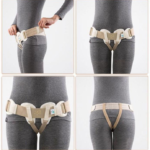Why do I need a bandage for inguinal hernia
Inguinal hernia is a fairly common pathology not only among young children, but also among adults. For its treatment, a bandage is often prescribed - a special belt of a specific cut, which will be useful during conservative therapy, as well as in the period after surgery.
A bandage for inguinal hernia may differ in cut, design, and wearing features. How to choose an orthopedic device, what are the indications and contraindications for its use?
Why do you need a bandage
When a protrusion appears, the belt must be worn to prevent its further increase and loss due to its large size. If the hernia is small, the bandage will help not only hide its presence without surgery, but also improve the patient's quality of life.
It is necessary to start wearing as soon as the first signs of pathology appear, that is, the appearance of a protrusion against the background of straining or physical exertion. The belt will help prevent a further increase in the hernia, and in some cases, against the background of selected physical exercises, it will help strengthen the muscle frame and non-surgical solution to the problem.
It is important to keep in mind that with large protrusions, any corset, regardless of the manufacturer, will only have a temporary effect. Sooner or later, surgery will still be necessary.
The goals that are achieved when using the design:
- keeping organs in one position, due to which the progression of the pathology slows down;
- fixation of protrusion for the period of loads;
- the ability to carry out exercise therapy without the threat of pinching or aggravating the situation;
- elimination of a visible defect that can cause discomfort.
Indications for wearing a bandage include:
- treatment without surgical intervention;
- preparation for intervention or a recent history of surgery;
- strong physical exertion due to the specifics of work (in order to prevent the development of inguinal hernia).
When use is prohibited
The inguinal hernia bandage is recommended for many patients due to the effectiveness of this simple design. However, despite all its advantages, there are contraindications in which it is forbidden to wear a belt.
These include:
- the presence of infringement, in which the patient does not need conservative treatment, but an immediate surgical operation;
- the presence of chronic skin pathologies, in which the belt will touch the foci of irritation, rub them and lead to an aggravation of the disease;
- the presence of malignant or benign tumors in the body.
The decision on whether a patient should wear an orthopedic structure always remains with the doctor.
Many patients tend to make a bandage for an inguinal hernia with their own hands. Doctors pay attention to the fact that such products do not have all the necessary qualities, and therefore their use is not recommended. Of course, you can make a bandage yourself, but it will not take into account all the anatomical and physiological features, and therefore it can do more harm than good.
Basic selection rules
A postoperative bandage or structure aimed at preventing a hernia must be chosen responsibly. In most cases, the corset is a set of straps, fasteners, strips of elastic material and several pads (special plates that provide fixation in the most problematic areas).
Before buying a product, be sure to consult with your doctor.
The store pays attention to:
- patient's age.
The bandage can be designed for both an adult and a small child. Ideally, you need to visit an orthopedic salon with the person who is buying the design. Blind buying is not recommended.
- position of the hernial protrusion.
Today there are both special (for a certain protrusion position) and universal belts. Versatility is a consequence of the use of special removable pads.
- gender of the patient.
Wearing a bandage is often necessary not only for men, but also for women. For the fair sex, there are special models or, in extreme cases, unisex products suitable for both sexes.
It is necessary to pay attention to the material from which the base of the bandage is made (it can be either shorts or swimming trunks, or just a wide belt). Preference should be given to natural fabrics, as they reduce the likelihood of irritation due to friction.
For wearing, according to many patients, the best products are in the form of underpants or swimming trunks. For example, bandages from Orlette or similar. Convenience is due to ease of donning and invisibility under normal clothing, which is important for some patients. In the manufacture of a home-made design, it will not be possible to achieve the same convenience and efficiency, and therefore its use is not recommended.
How to put on and wear the product
It is necessary to put on a bandage on the patient only when he lies on his back. During this period, the muscles relax as much as possible, which leads to spontaneous reduction of the hernial protrusion. After the structure is fixed with clamps, you need to get up and move around a little. This will help prevent tightness of fixed body parts and stiffness of movement.
If you feel pain, stiffness or other discomfort, you will have to remove the belt and put it on again to avoid infringing the hernia due to incorrect wearing of the corrective structure.
The bandage is used only during the daytime. Sleeping in the product is prohibited, as the body needs rest. The minimum recommended wearing time is 2-3 hours, but the maximum is limited to 16 hours (all the time a person is awake). If the made device has removable covers, then it may be necessary to adjust their position during the day.
Before going to bed, when the bandage has already been removed, it is recommended to carry out a light massage of the skin around the hernial protrusion. It is not recommended to touch the hernia itself.
If a defect appears in the groin area, it is recommended to wear a bandage for the entire time before surgery. After the operation, the corset is also used actively at first, and as the wound heals, only for periods of stress on the press or, if necessary, to stand a lot. Doctors draw the attention of patients to the fact that if they do not neglect wearing a corset after the intervention, the recurrence of the pathology develops very rarely.
A bandage, which is recommended for many patients when diagnosing an inguinal hernia, is a design aimed not only at prevention, but also at treating pathology. With the correct use of the corset, it is possible to significantly improve the quality of life of the patient, eliminate the aesthetic defect and properly prepare for surgery. The main thing is to choose the right bandage for wearing, following all the doctor's recommendations, and not trying to make it at home.










